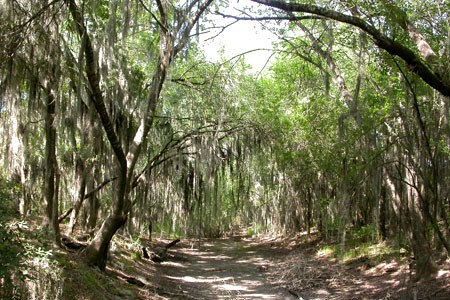(→Birds) |
m (categories) |
||
| Line 52: | Line 52: | ||
Image:santaananwr2.jpg | Image:santaananwr2.jpg | ||
</gallery> | </gallery> | ||
| − | [[Category:Texas]] [[Category:Locations]] [[Category: | + | [[Category:Texas]] [[Category:Locations]] [[Category:National Wildlife Refuges]] [[Category:Incomplete Locations]] |
Revision as of 19:45, 18 August 2008
Overview
Along the banks of the lower Rio Grande is the Santa Ana National Wildlife Refuge, a 2,088 acre refuge established in 1943 for the protection of migratory birds.
At an ecological crossroad, Santa Ana is strategically located where subtropical climate, gulf coast, great plains and Chihuahuan desert meet. Thousands of birds from the Central and Mississippi flyways funnel through the area on their way to and from Central and South America.
This small patch of midvalley riparian woodland is also habitat for about one half of all butterfly species found in the United States.
Birds
Notable Species
The 397 species of birds found on Santa Ana make it a birder's delight. Waterfowl, marsh birds and shorebirds can be seen on the lakes and wetlands of the refuge. Some species to look for are Black-bellied Whistling Duck and Fulvous Whistling Duck, Mottled Duck, Blue-winged Teal, Green-winged Teal, and Cinnamon Teal, Least Grebe, Anhinga, Tricolored Heron, White Ibis, Lesser Yellowlegs, Long-billed Dowitcher and Least Tern.
Migrating raptors that fly over the refuge in spring and fall include Osprey, Broad-winged Hawk, Northern Harrier and Peregrine Falcon. Santa Ana NWR's rarest raptors, the Hook-billed Kite and Gray Hawk, are seen occasionally on the refuge and attract birders from around the world.
Spring warblers are abundant, with over 35 species seen, including Golden-winged Warbler, Magnolia Warbler, Northern Parula and Tropical Parula, American Redstart, Palm Warbler and Yellow-breasted Chat.
Other specialties found in the lower Rio Grande Valley include the Buff-bellied Hummingbird, Roseate Spoonbill, Masked Duck, Plain Chachalaca, Red-billed Pigeon, Inca Dove, Ruddy Ground Dove, Groove-billed Ani, Pauraque, Ringed Kingfisher and Green Kingfisher, Couch's Kingbird and Tropical Kingbird, Great Kiskadee, Green Jay, Clay-colored Robin and Chihuahuan Raven.
Rarities
Rarities include Crane Hawk (1 record).
Check-list
Birds you can see here include:
To do
Other Wildlife
Considered the "jewel" of the refuge system, this essential "island" of thorn forest habitat is host or home to nearly 400 different types of birds and a myriad of other species, including the Indigo snake, malachite butterfly and the endangered Ocelot.
Site Information
History and Use
Before dams and control structures significantly reduced the flow of the Rio Grande, periodic floods cut shifting channels into the delta creating crescent-shaped oxbow lakes, referred to as "resacas".
Santa Ana's management program mimics the historical flooding of the Rio Grande, maintaining the bottom land hardwood forest and providing crucial nesting and feeding habitat for birds, watering holes for animals, and homes for countless amphibians, reptiles, crustaceans and insects.
With over 95 percent of the original habitat in the lower Rio Grande delta cleared or altered, Santa Ana is a reminder of the semitropical thorn forest that once dominated the area.
Areas of Interest
To do
Access and Facilities
To do
Contact Details
To do
External Links
To do
Content and images originally posted by Gaga





